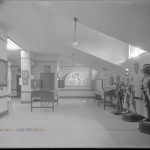Written by Leanna Barcelona
For many students and surrounding community members, the University’s William R. and Clarice V. Spurlock Museum remains a hidden gem on campus. While the museum promotes learning about history and cultures all over the world, it in itself has quite a rich history at the university.

Prior to existing next to the Krannert Performing Arts Center, the museum resided on the fourth floor of Lincoln Hall from 1911 to 1998 as three separate museums; the Classical Museum, the European Cultures Museum, and the Oriental and Archaeology Museum. Over the years, the museums were merged together and renamed several times, eventually becoming one unified museum known as the World Heritage Museum in the 1970s. William and Clarice Spurlock made a generous donation in 1990 that allowed the museum to expand and relocate to a new facility. The moving process began in 1998 and the brand new World Heritage Museum opened in 2002 with a new name as well; the Spurlock Museum. [1]
With the new building and new name also came new museum philosophy changes . In a 1997 memo sent to museum staff regarding new exhibit guidelines, Sarah Wissemen said:
“The Spurlock Museum of World Cultures is a cultural-historical museum, not an art museum. Our emphasis is on the story behind the object (how it was made, how it functioned, who made it, how it reveals religious, social, or other themes) and how objects and processes change over time.” [2]
These guidelines remain true today, with artifacts on display from all over the world, each telling a story about varying spaces and time.